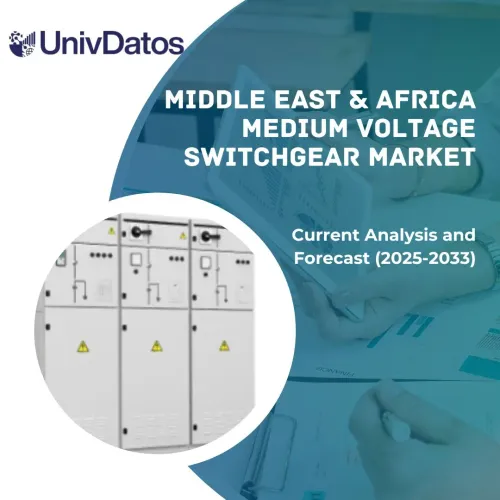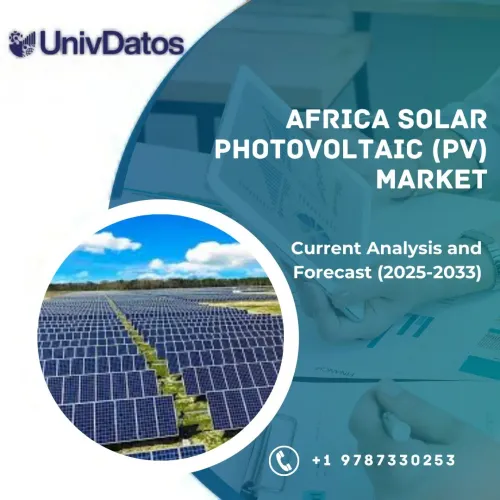- Home
- About Us
- Industry
- Services
- Reading
- Contact Us
Perovskite Solar Cells Market: Current Analysis and Forecast (2023-2030)
Emphasis on Structure (Planar Perovskite Solar Cells, and Mesoporous Perovskite Solar Cells), Product (Rigid Perovskite Solar Cells, and Flexible Perovskite Solar Cells, Sales (Solution Method, Vapor-Deposition Method, and Vapor-Assisted Solution Method), Application (Smart Glass, Solar Panel, Perovskite in Tandem Solar Cells, Portable Devices, Utilities, and End Use (Manufacturing, Energy, Industrial Automation, Aerospace, and Consumer Electronics) and Region/Country
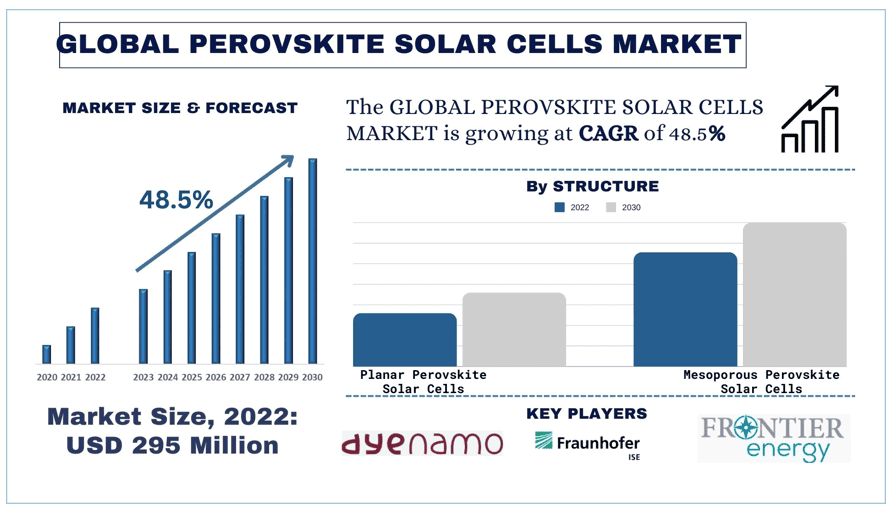
Perovskite Solar Cells Market Size and Forecast
The Perovskite Solar Cells Market is expected to grow at a strong CAGR of around 48.56 % during the forecast period (2023-2030).
Perovskite Solar Cells Market Analysis
The Perovskite Solar Cell Market is expected to witness significant growth in the coming years, driven by the cost of manufacturing perovskite solar cells which is expected to decline significantly in the coming years, as the technology matures and economies of scale are achieved. This will make perovskite solar cells more competitive with traditional silicon solar cells. Additionally, Governments around the world are providing financial and regulatory support for the development and deployment of renewable energy technologies. This support is helping to accelerate the growth of the perovskite solar cell market. Furthermore, Perovskite solar cell technology is still under development, but researchers are making rapid progress in improving the efficiency, stability, and scalability of these devices. These advancements are making perovskite solar cells increasingly attractive for commercial applications. Overall, the perovskite solar cell market is poised for significant growth in the coming years, driven by a combination of technological advancements, government support, falling costs, and growing demand for renewable energy.
Some of the major players operating in the market are Dyenamo AB, Energy Materials Corp, Fraunhofer ISE, Panasonic Holdings Corporation, Frontier Energy Solution, FrontMaterials Co. Ltd., FUJIFILM Wako Pure Chemical Corporation, Toshiba Corporation, G24 Power Ltd, and Tandem PV, Inc. Several M&As along with partnerships have been undertaken by these players to facilitate customers with hi-tech and innovative products/technologies.
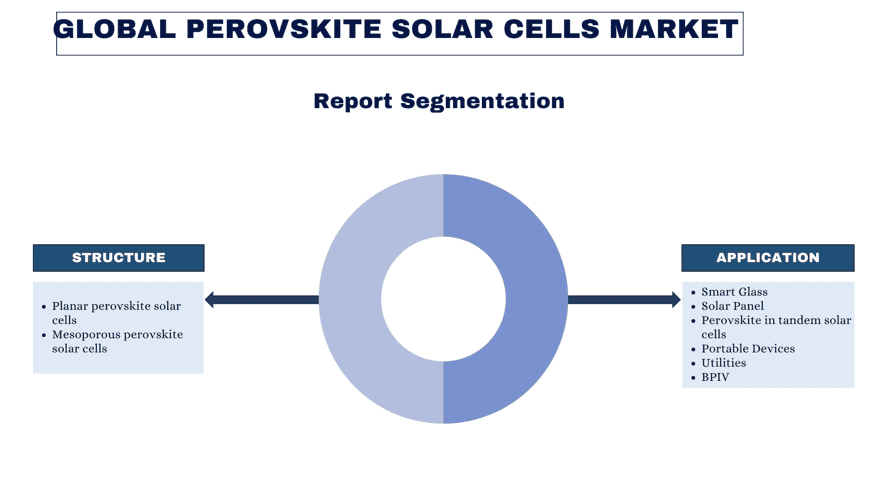
Perovskite Solar Cells Market Trends
“Amongst structure, the mesoporous perovskite solar cells segment held significant growth in the market in 2022.”
Based on structure, the market is segmented into planar perovskite solar cells and mesoporous perovskite solar cells. Amongst these, the segment with the significant growth in the perovskite solar cell market is planar perovskite solar cells because mesoporous perovskite solar cells have demonstrated improved stability compared to their non-mesoporous counterparts, which helps to reduce degradation over time. Additionally, the mesoporous structure of these solar cells provides increased surface area, allowing for more efficient adsorption of light and improved charge transfer.
“Amongst application , the smart glass segment held a significant growth in the market. ’’
Based on application, the market is segmented into smart glass, solar panel, perovskite in tandem solar cells, portable devices, utilities, and BIPV (building-integrated photovoltaics). Amongst these, the solar panel segment has significant growth in the perovskite solar cell market because Smart glass coated with perovskite solar cells can generate electricity while allowing natural light to pass through, reducing the need for artificial lighting and air conditioning. This results in significant energy savings. Additionally, Smart glass coated with perovskite solar cells can be designed to darken or tint upon exposure to UV rays, providing an additional layer of security against intruders.
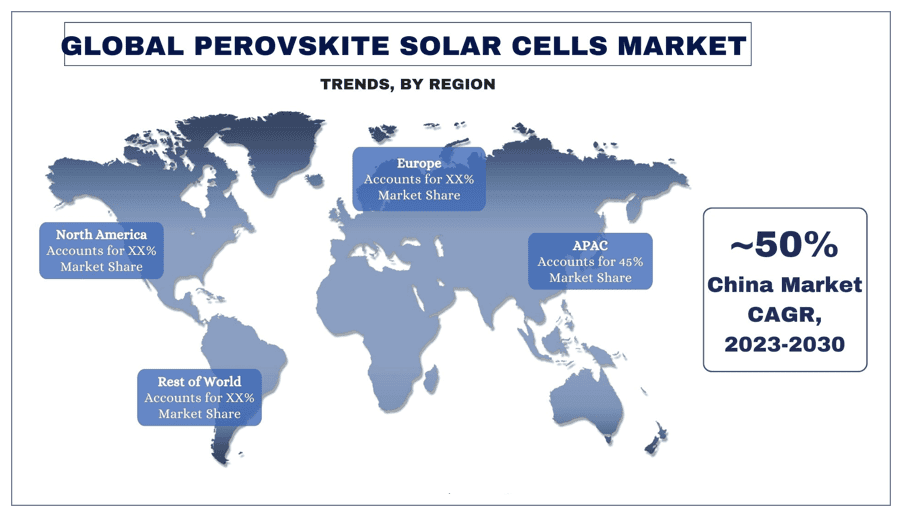
“Europe has significant growth in the perovskite solar cells market in 2022.”
Europe has significant growth in the perovskite solar cells market because European countries have implemented various policies and incentives aimed at promoting the use of renewable energy sources. This has created a favorable environment for companies involved in the production and commercialization of perovskite solar cells. Additionally, European countries have invested heavily in research and development of perovskite solar cells. The European Union’s Horizon 2020 program alone has provided funding for several projects focused on improving the efficiency and stability of perovskite solar cells. Furthermore, Europe has a well-developed infrastructure for the production and distribution of renewable energy solutions. This makes it easier for companies to scale up their production of perovskite solar cells and bring them to market.Overall, these factors have contributed to significant growth in the perovskite solar cell market in Europe, and the trend is expected to continue as the demand for clean energy sources increases globally.
Perovskite Solar Cells Market Report Coverage
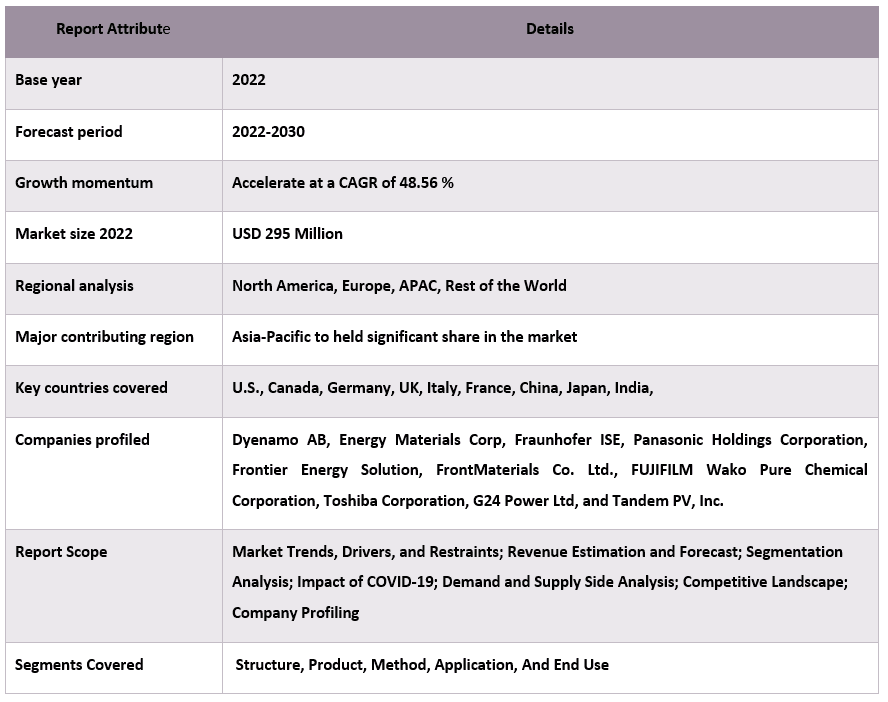
Reasons to buy this report:
- The study includes market sizing and forecasting analysis validated by authenticated key industry experts.
- The report presents a quick review of overall industry performance at one glance.
- The report covers an in-depth analysis of prominent industry peers with a primary focus on key business financials, product portfolios, expansion strategies, and recent developments.
- Detailed examination of drivers, restraints, key trends, and opportunities prevailing in the industry.
- The study comprehensively covers the market across different segments.
- Deep dive regional level analysis of the industry.
Customization Options:
The global perovskite solar cells market can further be customized as per the requirement or any other market segment. Besides this, UMI understands that you may have your own business needs, hence feel free to connect with us to get a report that completely suits your requirements.
Table of Content
Research Methodology for the Perovskite Solar Cells Market Analysis (2023-2030)
Analyzing the historical market, estimating the current market, and forecasting the future market of the global perovskite solar cells market were the three major steps undertaken to create and analyze the adoption of perovskite solar cells in major regions globally. Exhaustive secondary research was conducted to collect the historical market numbers and estimate the current market size. Secondly, to validate these insights, numerous findings and assumptions were taken into consideration. Moreover, exhaustive primary interviews were also conducted, with industry experts across the value chain of the global perovskite solar cells market. Post assumption and validation of market numbers through primary interviews, we employed a top-down/bottom-up approach to forecasting the complete market size. Thereafter, market breakdown and data triangulation methods were adopted to estimate and analyze the market size of segments and sub-segments of the industry pertains to. Detailed methodology is explained below:
Analysis of Historical Market Size
Step 1: In-Depth Study of Secondary Sources:
Detail secondary study was conducted to obtain the historical market size of the perovskite solar cells market through company internal sources such as annual reports & financial statements, performance presentations, press releases, etc., and external sources including journals, news & articles, government publications, competitor publications, sector reports, third-party database, and other credible publications.
Step 2: Market Segmentation:
After obtaining the historical market size of the perovskite solar cells market, we conducted a detailed secondary analysis to gather historical market insights and share for different segments & sub-segments for major regions. Major segments are included in the report like structure, product, method, application, and end use. Further country-level analyses were conducted to evaluate the overall adoption of testing models in that region.
Step 3: Factor Analysis:
After acquiring the historical market size of different segments and sub-segments, we conducted a detailed factor analysis to estimate the current market size of the perovskite solar cells market. Further, we conducted factor analysis using dependent and independent variables such as increasing vehicle productions. A thorough analysis was conducted of demand and supply-side scenarios considering top partnerships, mergers and acquisitions, business expansion, and product launches in the perovskite solar cells market sector across the globe.
Current Market Size Estimate & Forecast
Current Market Sizing: Based on actionable insights from the above 3 steps, we arrived at the current market size, key players in the global perovskite solar cells market, and market shares of the segments. All the required percentage shares split, and market breakdowns were determined using the above-mentioned secondary approach and were verified through primary interviews.
Estimation & Forecasting: For market estimation and forecast, weights were assigned to different factors including drivers & trends, restraints, and opportunities available for the stakeholders. After analyzing these factors, relevant forecasting techniques i.e., the top-down/bottom-up approach were applied to arrive at the market forecast for 2028 for different segments and sub-segments across the major markets globally. The research methodology adopted to estimate the market size encompasses:
- The industry’s market size, in terms of revenue (USD) and the adoption rate of the perovskite solar cells market across the major markets domestically
- All percentage shares, splits, and breakdowns of market segments and sub-segments
- Key players in the global perovskite solar cells market in terms of products offered. Also, the growth strategies adopted by these players to compete in the fast-growing market.
Market Size and Share Validation
Primary Research: In-depth interviews were conducted with the Key Opinion Leaders (KOLs) including Top Level Executives (CXO/VPs, Sales Head, Marketing Head, Operational Head, Regional Head, Country Head, etc.) across major regions. Primary research findings were then summarized, and statistical analysis was performed to prove the stated hypothesis. Inputs from primary research were consolidated with secondary findings, hence turning information into actionable insights.
Split of Primary Participants in Different Regions
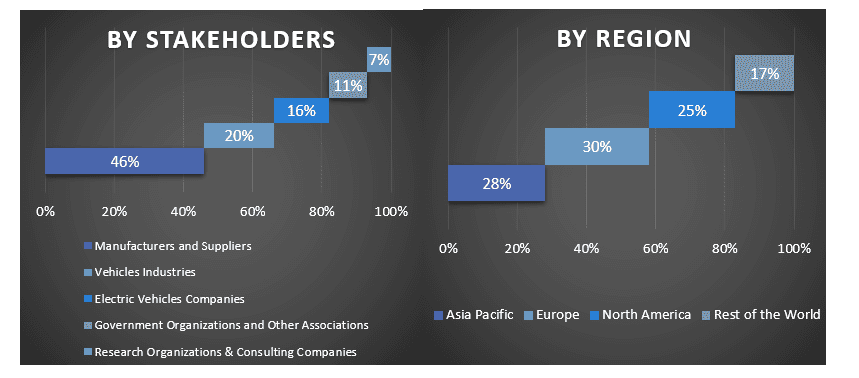
Market Engineering
The data triangulation technique was employed to complete the overall market estimation and to arrive at precise statistical numbers for each segment and sub-segment of the global perovskite solar cells market. data was split into several segments & sub-segments after studying various parameters and trends in the areas of vehicle type and technology in the global perovskite solar cells market.
The main objective of the Global Perovskite Solar Cells Market Study
The current & future market trends of the global perovskite solar cells market were pinpointed in the study. Investors can gain strategic insights to base their discretion for investments on the qualitative and quantitative analysis performed in the study. Current and future market trends determined the overall attractiveness of the market at a regional level, providing a platform for the industrial participant to exploit the untapped market to benefit from a first-mover advantage. Other quantitative goals of the studies include:
- Analyze the current and forecast market size of the perovskite solar cells market in terms of value (USD). Also, analyze the current and forecast market size of different segments and sub-segments.
- Segments in the study include areas of the as like structure, product, method, application, and end use.
- Define and analyze the regulatory framework for the perovskite solar cells
- Analyze the value chain involved with the presence of various intermediaries, along with analyzing customer and competitor behaviors of the industry.
- Analyze the current and forecast market size of the perovskite solar cells market for the major region.
- Major countries of regions studied in the report include Asia Pacific, Europe, North America, and the Rest of the World
- Company profiles of the perovskite solar cells market and the growth strategies adopted by the market players to sustain in the fast-growing market.
- Deep dive regional level analysis of the industry.
Frequently Asked Questions FAQs
Q1: What is the current market size and growth potential of the global perovskite solar cells market?
Q2: What are the driving factors for the growth of the global perovskite solar cells market?
Q3: Which segment has the largest share of the global perovskite solar cells market by structure?
Q4: Which region will dominate the global perovskite solar cells Market?
Q5: Who are the key players operating in the global perovskite solar cells market?
Related Reports
Customers who bought this item also bought






